The 14 preschoolers sat shoulder to shoulder in a circle and sang their morning song, then turned their attention to their teacher to listen to the plan for the day.
They still needed to take care of circle time chores and talk about the weather, but they were already focused on what would come after.
Like every Tuesday, they were going to play with their “grandfriends.”
“I hope my grandfriend is there!” one child called out. “Can I give him a hug?”
The Gorham House preschool looks much like any other, with colorful art on the wall, shelves of books and cubbies stuffed with coats and backpacks.
But the classroom door opens to the great room of the Gorham House, a senior living community that includes a nursing home, assisted and independent living, and a memory care unit. The unique setup allows the children and residents to interact throughout the day and form relationships that bridge the two-generation gap.
The children bring a tremendous energy and joy to daily life at the Gorham House, those who live and work there say. Ages 3 to 5, they learn empathy and how to interact with people who may communicate or move differently than they do.
“For those of us that are observing it, there have been moments when we are so moved by these connections that we can’t help but become very emotional,” preschool director Meghan Pomelow said. “It is so special to experience it and see the love between them.”

Parker DuEst, 4, helps Byron Shaw, 81, back to his room at the Gorham House on Tuesday, after preschoolers spent the morning singing songs, reading books and doing other activities with their “grandfriends” who live in the nursing home. Shawn Patrick Ouellette/Staff Photographer
Bill Gillis, who was regarded as a trailblazer in long-term care in Maine before his death in 2017, was a young father of five when he opened Clover Manor in Auburn in 1980 and created the first intergenerational child care center in the state. When he opened Gorham House nine years later, he also included a preschool. The program later expanded to Durgin Pines in Kittery.
“It was his vision to have the children and residents under the same roof,” Pomelow said. “He was a father and realized the importance of helping working parents, especially single moms, who strived to provide the best life they could for their families. We’ve been thriving ever since.”
The Gorham House preschool is among about 130 similar programs across the country, according to Generations United, a Washington, D.C., nonprofit that advocates for intergenerational programs and grandparent-led households. Sheri Steinig, the organization’s strategic initiatives director, said she regularly hears from people who are interested in starting intergenerational programs.
“We know that there can be more and there should be more,” she said.
There is a growing body of research that shows interactions between the very young and older generations are beneficial for everyone involved, Steinig said. They help improve self-esteem and confidence, enhance life satisfaction and improve moods. In older adults, the programs decrease depression, improve communication skills and reduce isolation, a benefit that is particularly important at a time when Americans are increasingly lonely and isolated.
“There’s this positivity and hope that comes from these types of interactions,” Steinig said.
LIFE LESSONS
The preschoolers are making their way through their circle time activities when 89-year-old Annunciatta “Nancy” Hunter comes into the classroom, a small May Day basket tucked in the front of her walker. The day before, the children made and hung the paper baskets, filled with flowers and chocolate, on each grandfriend’s door.
“I got a surprise yesterday,” she says. “I wanted to come by and thank the people who did it.”
“It was us!” the kids call out.
“It was such a surprise I almost cried. Why? Because I was so happy,” she tells them. “That just made my day.”

Lily Martin, 4, peeks out from the preschool with her classmates as their “grandfriends” gather for activities at the Gorham House. Shawn Patrick Ouellette/Staff Photographer
Hunter moved to an apartment at Gorham House last year, and her husband lives in the nursing home unit. Their family is all grown up, she said, but she gets a kick out of watching the preschoolers dance, sing and talk to their grandfriends.
“To have this here and integrated with the residents, it’s just something you look back on and say, ‘Oh, my gosh.’ How innocent and wonderful it is to see these kids’ energy going to school,” she said. “When you’re alone, it sure sparks up your day.”
Sally Thompson, assistant director of independent living at Gorham House, said it’s amazing to see the relationships it creates. It’s especially touching to see residents with dementia connect with them, she said.
“The patients just light up,” she said. “It’s such a wonderful treat to have the preschool here.”
Thompson’s 4-year-old grandson Caleb is in the preschool now, and his older brother attended a few years ago. Their younger sibling is already on the waitlist. It’s not hard to see how the children benefit, she said.
“For little ones, it can be frightening to see an older person in a wheelchair and with an oxygen tank. But they see it from a young age, and it’s not bothersome to them,” she said.
Pomelow said she often hears from local elementary school teachers that there’s something special about the kids who come from Gorham House.
“They have that true feeling in their heart of caring for others,” she said. “They’re the ones who take a child in a wheelchair under their wing. Our children learn to truly accept others for who they are, without judgment.”
SPECIAL CONNECTIONS
Over the years, the preschoolers have had to learn about death.
When one patient, Pauline, died several years ago, the class was adamant about visiting her room.
“The children looked around the room and realized she really wasn’t there anymore. One child said, ‘She really is gone,'” Pomelow said. “This visit into her room gave the children the closure they were looking for, and the children moved on and were at peace with her passing. It was a very eye-opening moment to see that children were looking for concrete evidence of her passing, rather than this very abstract concept of death and dying.”
Sometimes those conversations start when the children notice a grandfriend is not in their room, Pomelow said. The class will read “Nana Upstairs and Nana Downstairs” by Tomie dePaola, the story of a little boy coping with the loss of his great-grandmother, then the kids ask questions.
“We are very open and honest with the children, yet keep the explanations age-appropriate, also keeping in mind the beliefs and values of all our families,” Pomelow said. Parents are told when these conversations happen so they can also talk to their children at home.

Kullen Dumais, 5, talks with his “grandfriend,” Fred Bliss, 97, at the Gorham House. Shawn Patrick Ouellette/Staff Photographer
Throughout the week, residents stop by the preschool classroom to say hello and read books. If there’s music being played in the great room, the kids will head out to dance. They celebrate holidays together, have pizza parties, paint, play bingo and do puzzles. It turns out, Pomelow said, that the interests and skills of 4-year-olds and octogenarians are well aligned.
On Fridays, the children parade through the hallways with instruments and stop to sing to residents who can’t leave their rooms.
“Children make you smile, they’re silly and keep you young,” Pomelow said. “It’s almost like additional therapy for the grandfriends. Those who don’t typically come out of rooms will often come out to be with the children.”
That face-to-face time was completely cut off during the first year of the pandemic when strict protocols were put in place to protect vulnerable residents. The preschool teachers and activities staff did what they could to maintain the connections between the two groups through virtual story time and sing-alongs.
When they were finally reunited, it was clear just how much everyone had missed each other and how important it is to have the children and residents together, Pomelow said. Last week was the first time in three years they visited each other without masks.
A JOYFUL OCCASION
After Tuesday circle time wraps up, the preschoolers rush across their classroom to line up by the door. Four-year-old Lily Martin cranes her neck to try to see the residents as they settle in a circle of chairs, couches, wheelchairs and walkers. She is watching for 81-year-old Byron Shaw, whom she calls her best friend.
“I don’t know what draws her to him, but she’s super comfortable with him,” said Lily’s mom, Courtney Martin, a nurse manager at Gorham House. “And he’s very protective of her.”
As the kids file out of their room, Pomelow tells them to “find a grandfriend.”
Three kids, led by Lily, rush to Shaw, who is wearing a safety-orange bucket hat and sitting in a wheelchair next to a grand piano. He smiles widely when he sees them and points to the picture on the front of Lily’s tie-dye shirt. She giggles and follows her friends as they circle the room to greet everyone.

John Vivian, 89, taps a balloon back to Kullen Dumais 5, while his wife, Dawn Vivian, 89, relaxes as the two play together at the Gorham House. Shawn Patrick Ouellette/Staff Photographer
When Bridger Hanson, 5, stops in front of 88-year-old Yvette Gagnon, he shyly greets her with a “bonjour,” much to her delight. The preschoolers recently learned how to count in French. Another resident, 82-year-old Sue Lin, is teaching them how to count and sing in Chinese.
After the children sing a song and Pomelow reads a book about turtles, it’s finally time for balloon toss, a favorite for all ages at Gorham House.
One of the three preschool teachers brings out bright yellow and green balloons, and the kids eagerly scoop them up. Turning to their grandfriends, they begin bopping them back and forth. Someone switches on music, creating a party-like atmosphere.
Lily’s double French braids bounce against her back as she leaps around in front of Shaw, passing the balloon high above them. She giggles as he stretches to swat it back to her. Next to them, Fred Bliss, 97, and his wife, Catherine, 94, sit together on a couch and pass a balloon back and forth with 4-year-old Caleb Johnson.
Fred Bliss doesn’t talk much these days, but he lights up when the kids approach. He sits forward, his eyes trained on Caleb, as the boy jumps around in front of him and tosses the balloon into the air.
With their eyes on the balloon floating over them, Fred and Caleb reach up and laugh together.
Copy the Story LinkSend questions/comments to the editors.


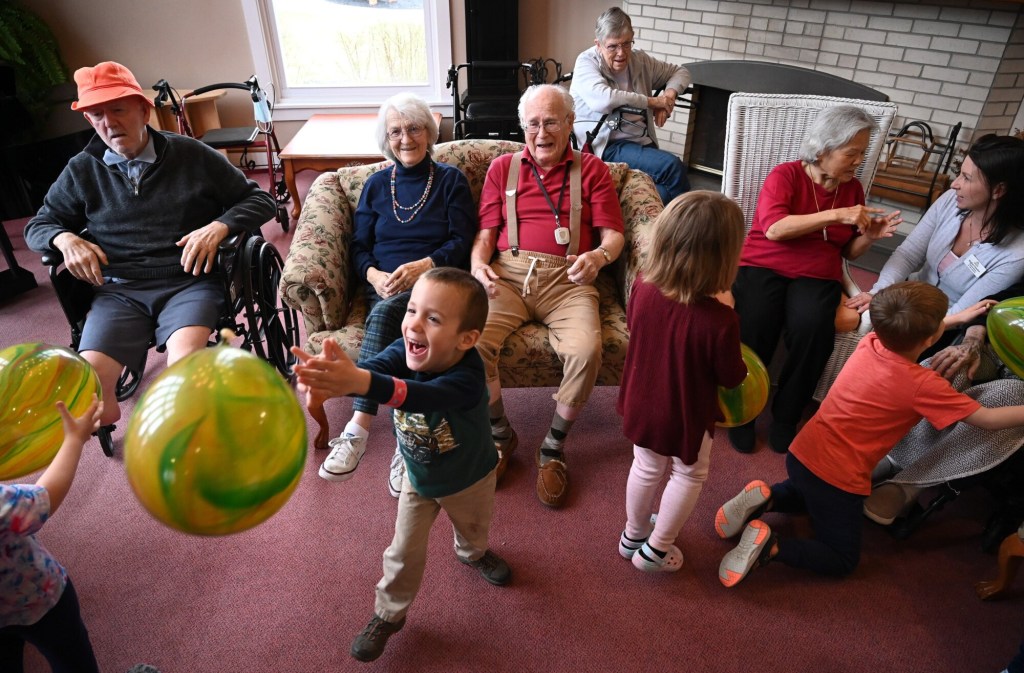
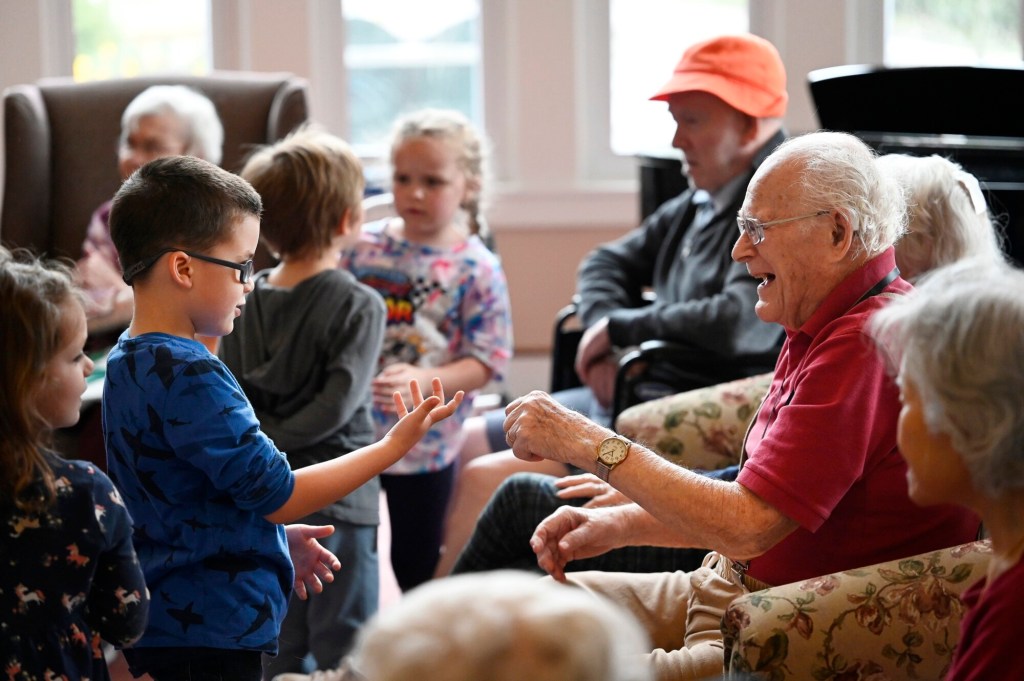
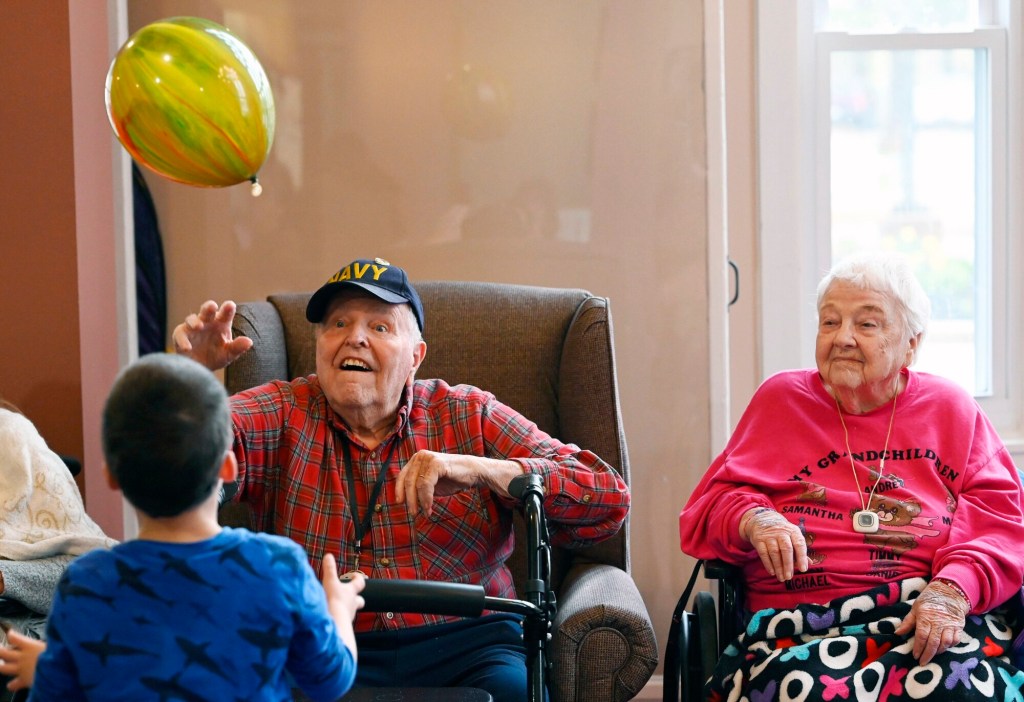
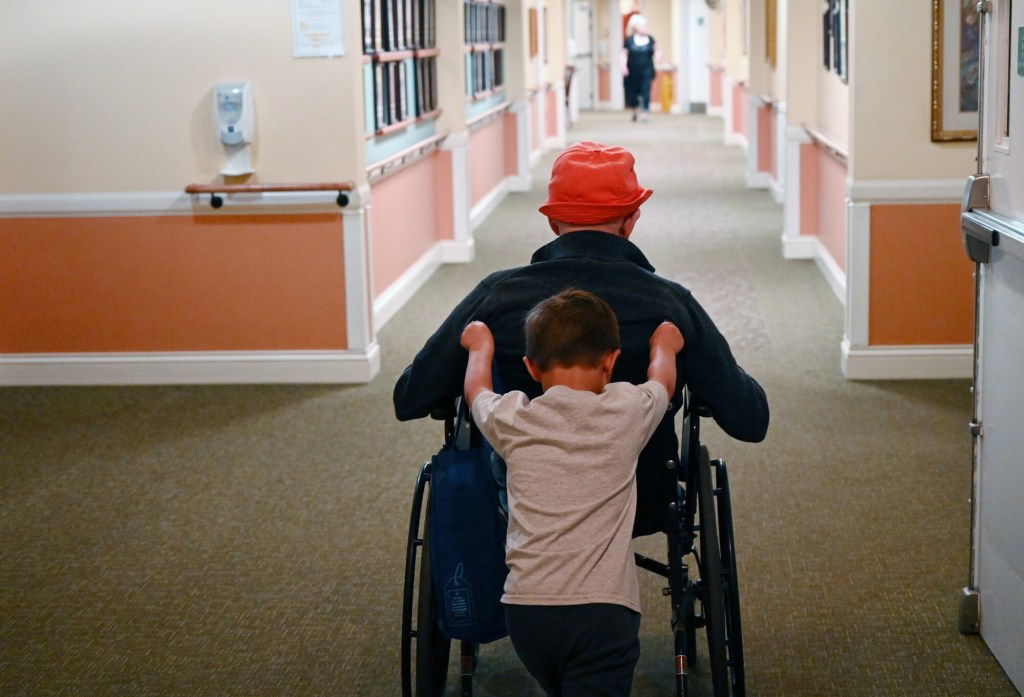
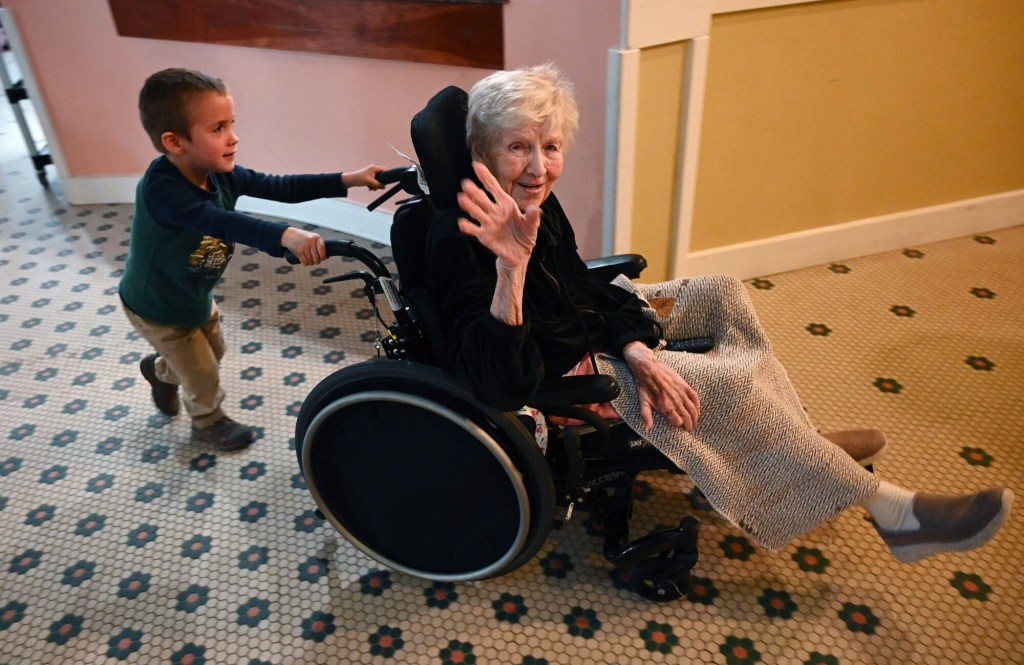
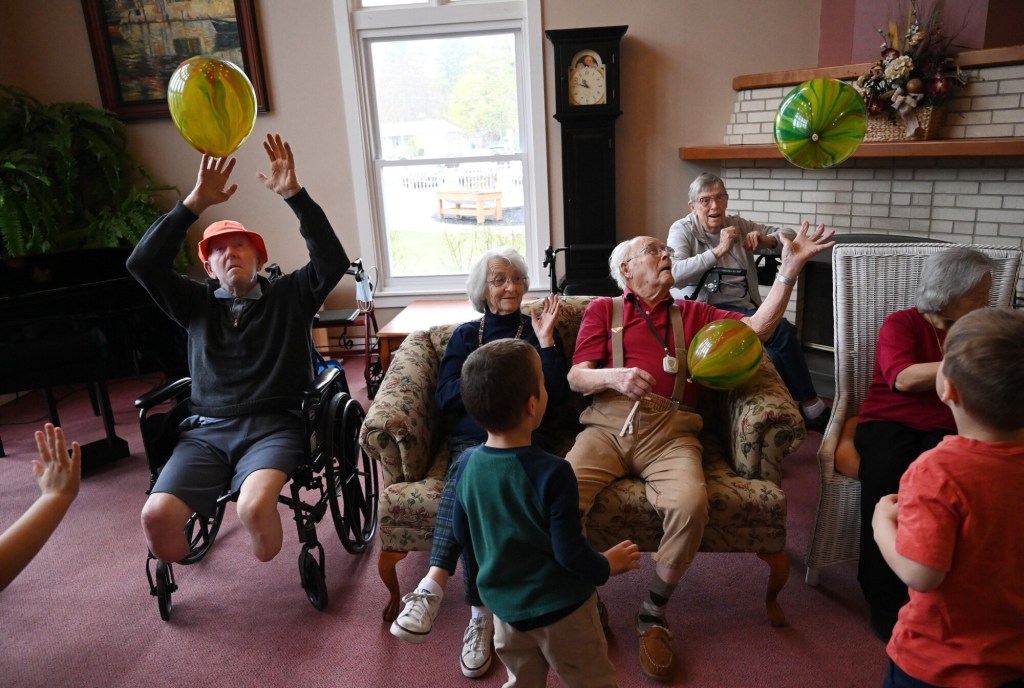
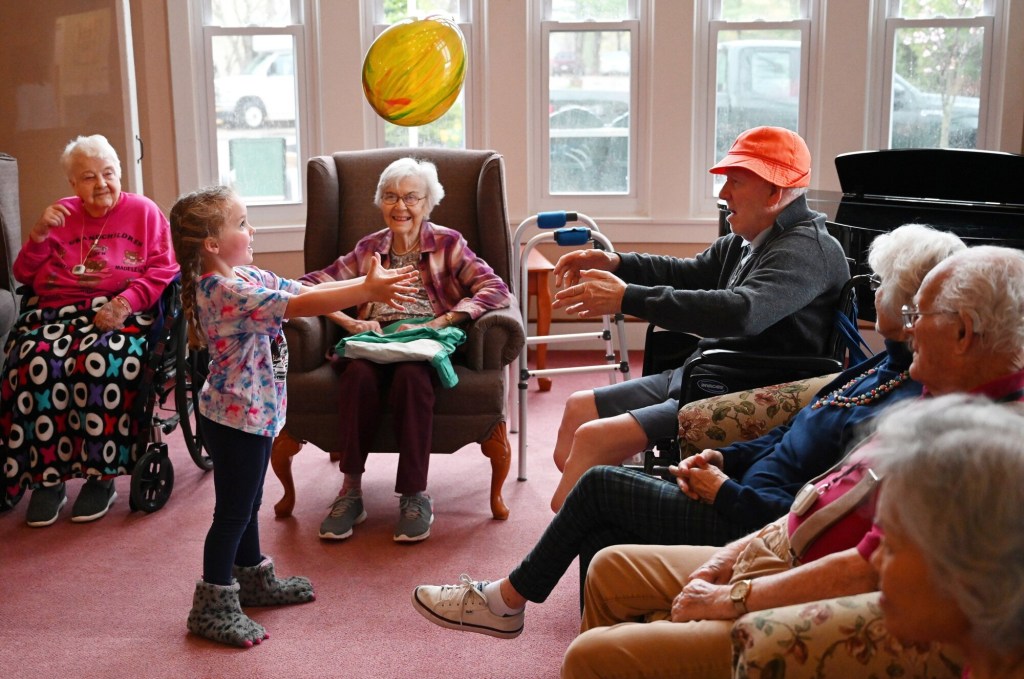
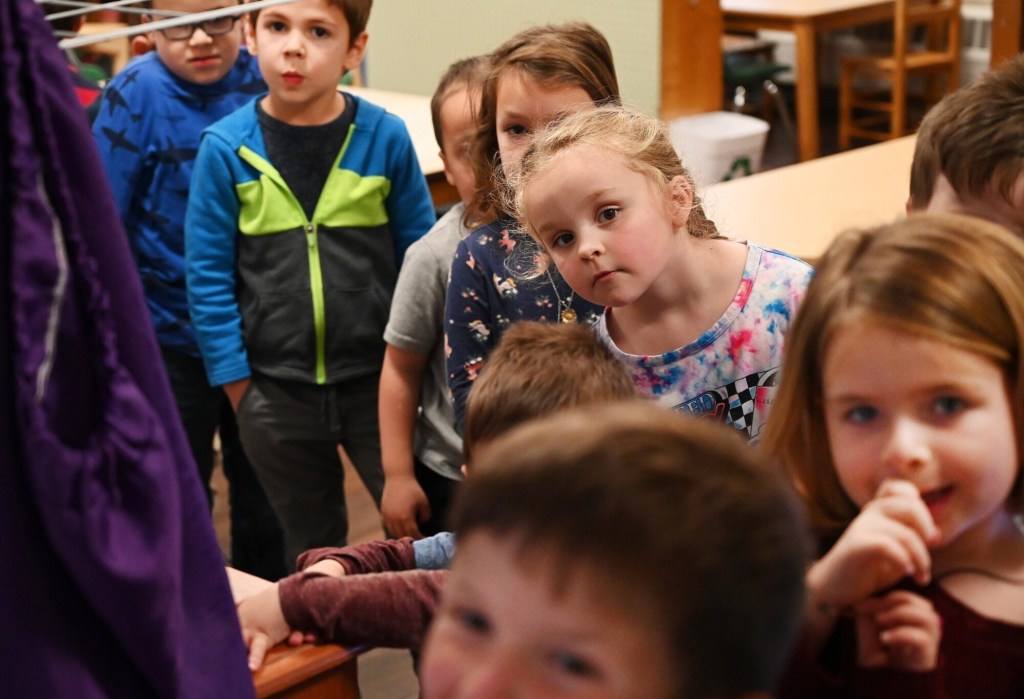

Success. Please wait for the page to reload. If the page does not reload within 5 seconds, please refresh the page.
Enter your email and password to access comments.
Hi, to comment on stories you must . This profile is in addition to your subscription and website login.
Already have a commenting profile? .
Invalid username/password.
Please check your email to confirm and complete your registration.
Only subscribers are eligible to post comments. Please subscribe or login first for digital access. Here’s why.
Use the form below to reset your password. When you've submitted your account email, we will send an email with a reset code.